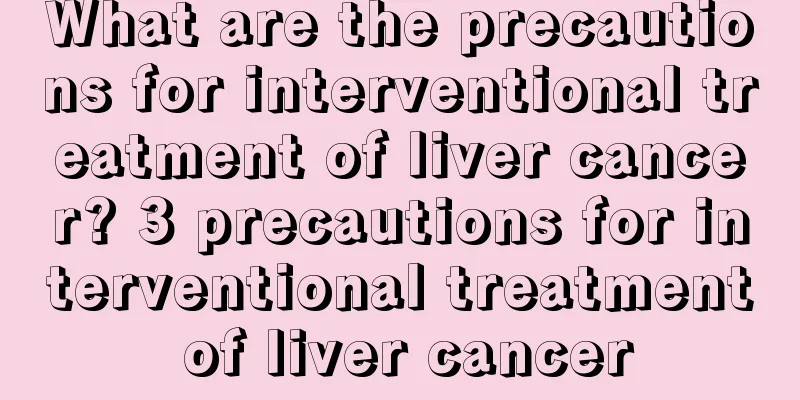What are the precautions for interventional treatment of liver cancer? 3 precautions for interventional treatment of liver cancer

|
1. Strictly grasp the indications and contraindications of interventional treatment of liver cancer. 2. Formulate a reasonable treatment plan. When formulating an interventional treatment plan, many relevant factors should be considered comprehensively, such as the size and shape of the tumor, blood supply, size and location of the tumor thrombus, arteriovenous shunt, liver function, blood count, physical potential, etc., to determine whether the patient is suitable for interventional treatment. If interventional treatment is the preferred option, choose the corresponding interventional treatment plan based on the patient's specific angiography. If angiography finds that the liver cancer is a hypovascular nodular type, the interventional treatment effect is not ideal, and other therapies should be recommended. Multi-slice spiral CT (MSCT) is one of the major advances in CT technology in recent years. Due to its fast scanning speed, it can not only display relevant information about tumors and their complications, and improve the detection rate of lesions, but also display the anatomy and course of blood vessels, the size, number, degree of enhancement and distribution range of tumors, the presence or absence of portal vein tumor thrombus, the location of formation, arteriovenous fistula, the presence or absence of obstructive jaundice and the amount of ascites, the presence or absence of abdominal lymph node enlargement, and whether the inferior vena cava is invaded. These information are of great guiding significance for judging whether the patient is suitable for interventional treatment and formulating a reasonable treatment plan. For those who are eligible, preoperative MSCT is of great guiding significance for formulating interventional treatment plans for liver cancer, performing targeted intubation, reducing the difficulty of finding target blood vessels, shortening operation time, and reducing the radiation dose of patients and interventional operators. 3. Matters that need to be noted during surgery. Because the blood supply arteries of liver cancer can mutate, the order of angiography should be noted for patients receiving treatment for the first time. Do not only perform celiac artery or superselective hepatic artery angiography. The superior mesenteric artery, celiac artery, and phrenic artery angiography should be performed in sequence, and superselective blood supply artery angiography should be performed according to the need for angiography. The intraoperative contrast agent situation should be compared with the preoperative CT and MRI examination results, and carefully analyzed to avoid missing multiple blood supply arteries that may exist. Standardized intraoperative operation not only guarantees the effect of interventional treatment, but also creates good conditions for subsequent comprehensive treatment, while reducing the occurrence of complications. During embolization, the following principles can be followed: ① Use peripheral embolic agents for peripheral embolization first, and then central embolization. ② The amount of iodized oil should be sufficient, especially during the first embolization. ③ Do not completely occlude the proper hepatic artery to facilitate TAE again, but the exception is those with obvious hepatic artery-portal vein fistula. ④ If there are two or more arteries supplying the liver tumor, each artery should be embolized one by one to devascularize the tumor. ⑤ For patients with smaller hepatic artery-portal vein fistulas, iodized oil embolization can still be used, but it should be done with caution. ⑥ Try to avoid the embolic agent entering non-target organs. When performing TAI, the amount of chemotherapy drugs used in perfusion and embolization should be allocated according to the blood supply characteristics of liver cancer. |
>>: What are the early symptoms of lung cancer? Five clinical symptoms of early lung cancer
Recommend
What to do if my throat hurts after eating
Sore throat is particularly uncomfortable, and ev...
Are the protruding blood vessels on the forehead blue veins?
Many people often find that they have protruding ...
Can scraping remove nodules?
From the perspective of traditional Chinese medic...
What will the biological clock disorder lead to
Everyone has their own biological clock in their ...
Dangers of putting ginger in the navel
Ginger is a very common condiment in our daily li...
How to prevent hypoxia due to cardiovascular and cerebrovascular diseases
With the increasing incidence of cardiovascular a...
Can eating peach gum regularly help whiten your skin?
Every woman hopes to have fair and delicate skin,...
What can’t be shared?
Normally when people are at home, many things are...
Can kidney cancer also cause liver damage?
One of the causes of liver damage: excessive drin...
What can a chest x-ray show?
Chest X-ray is a type of X-ray examination, and c...
What is the reason for often twisting the waist
The waist is a very fragile part. People often ac...
What are the obvious signs that the liver is calling for help
Medically, the liver is the center of the human b...
Correlation with prostate cancer
Prostate cancer is a disease that is common among...
What are the Chinese herbal medicines for treating nasopharyngeal carcinoma
What are the Chinese herbal medicines for treatin...
What medicine should I apply to the ant bite for redness and swelling
Ants are a very common animal in normal times, bu...









